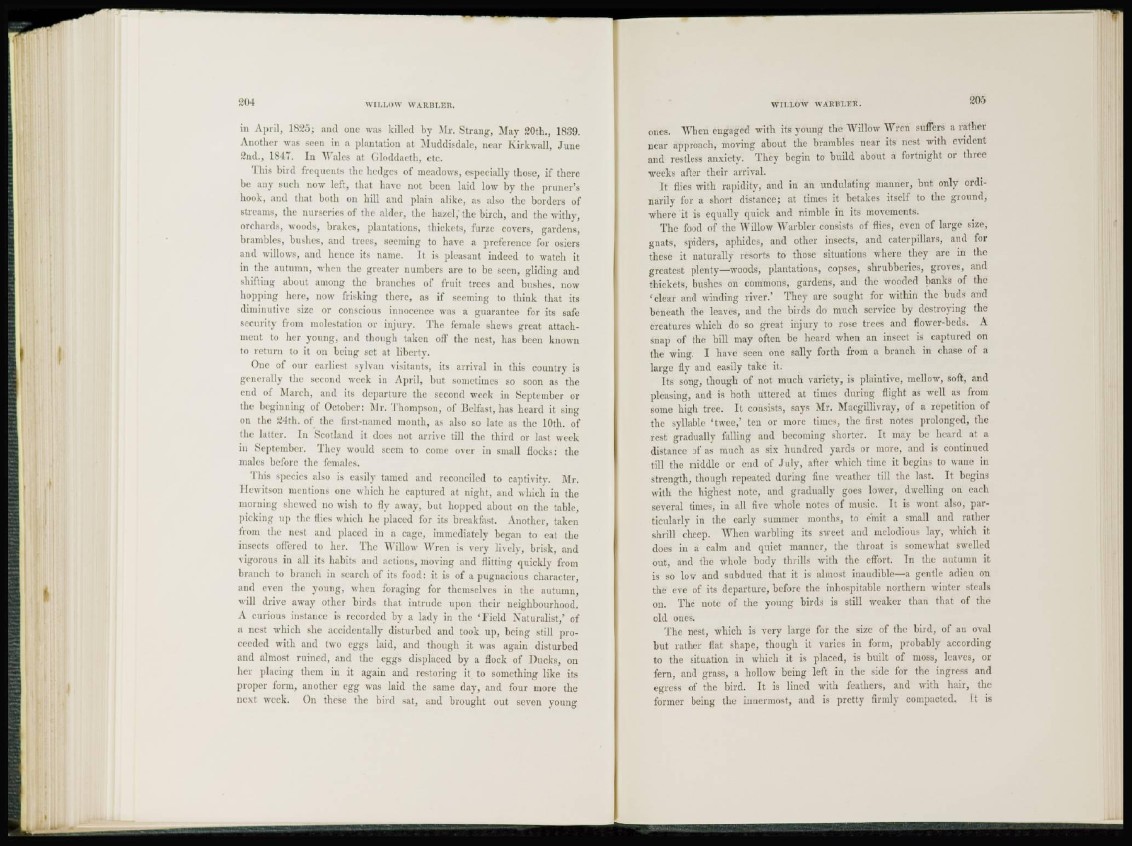
in April, 1825; and one was killed by Mr. Strang, May 20th., 1839.
Another was seen in a plantation at Muddisdale, near Kirkwall, June
2nd., 1817. In Wales at Gloddaeth, etc.
This bird frequents the hedges of meadows, especially those, if there
be any such now left, that have not been laid low by the primer's
hook, and that both on hill and plain alike, as also the borders of
streams, the nurseries of the alder, the hazel, the birch, and the withy,
orchards, woods, brakes, plantations, thickets, furze covers, gardens,
brambles, bushes, and trees, seeming to have a preference for osiers
and willows, and hence its name. It is pleasant indeed to watch it
in the autumn, when the greater numbers are to be seen, gliding and
shifting about among the branches of fruit trees and bushes, now
hopping here, now frisking there, as if seeming to think that its
diminutive size or conscious innocence was a guarantee for its safe
security from molestation or injury. The female shews great attachment
to her young, and though taken off the nest, has been known
to return to it on being set at liberty.
One of our earliest sylvan visitants, its arrival in this country is
generally the second week in April, but sometimes so soon as the
end of March, and its departure the second week in September or
the beginning of October: Mr. Thompson, of Belfast, has heard it sing
on the 24th. of the first-named month, as also so late as the 10th. of
the latter. In Scotland it does not arrive till the third or last week
in September. They would seem to come over in small flocks: the
males before the females.
This species also is easily tamed and reconciled to captivity. Mr.
Hewitson mentions one which he captured at night, and which in the
morning shewed no wish to fly away, but hopped about on the table,
picking up the flies which he placed for its breakfast. Another, taken
from the nest and placed in a cage, immediately began to eat the
insects offered to her. The ^\ illow Wren is very lively, brisk, and
vigorous in all its habits and actions, moving and flitting quickly from
branch to branch in search of its food: it is of a pugnacious character,
and even the young, when foraging for themselves in the autumn,
will drive away other birds that intrude upon their neighbourhood.
A curious instance is recorded by a lady in the ' F i e l d Naturalist/ of
a nest which she accidentally disturbed and took up, being still proceeded
with and two eggs laid, and though it was again disturbed
and almost ruined, and the eggs displaced by a flock of Ducks, on
her placing them in it again and restoring it to something like its
proper form, another egg was laid the same day, and four more the
next week. On these the bird sat, and brought out seven young
ones. When engaged with its young the Willow Wren suffers a rather
near approach, moving about the brambles near its nest with evident
and restless anxiety. They begin to build about a fortnight or three
weeks after their arrival.
It flies with rapidity, and in an undulating manner, but only ordinarily
for a short distance; at times it betakes itself to the ground,
where it is equally quick and nimble in its movements.
The food of the Willow Warbler consists of flies, even of large size,
gnats, spiders, aphides, and other insects, and caterpillars, and for
these it naturally resorts to those situations where they are in the
greatest plenty—woods, plantations, copses, shrubberies, groves, and
thickets, bushes on commons, gardens, and the wooded hanks of the
'clear and winding river.' They arc sought for within the buds and
beneath the leaves, and the birds do much service by destroying the
creature's which do so great injury to rose trees and flower-beds. A
snap of the bill may often be heard when an insect is captured on
the wing. I have seen one sally forth from a branch in chase of a
large fly and easily take it.
Its song, though of not much variety, is plaintive, mellow, soft, and
pleasing, and is both uttered at times during flight as well as from
some high tree. It consists, says Mr. Macgillivray, of a repetition of
the syllable 'twee,' ten or more times, the first notes prolonged, the
rest gradually falling and becoming shorter. It may be heard at a
distance of as much as six hundred yards or more, and is continued
till the middle or cud of July, after 'which time it begins to wane in
strength, though repeated during fine weather till the last. It begins
with the highest note, and gradually goes lower, dwelling on each
several times, in all five whole notes of music. It is wont also, particularly
in the early summer months, to emit a small and rather
shrill cheep. When warbling its sweet and melodious lay, which it
does in a calm and quiet manner, the throat is somewhat swelled
out, and the whole body thrills with the effort. In the autumn it
is so low and subdued that it is almost inaudible—a gentle adieu on
the eve of its departure, before the inhospitable northern winter steals
on. The note of the young birds is still weaker than that of the
old ones.
The nest, which is very large for the size of the bird, of an oval
but rather flat shape, though it varies in form, probably according
to the situation in which it is placed, is built of moss, leaves, or
fern, and grass, a hollow being left in the side for the ingress and
egress of the bird. It is lined with feathers, and with hair, the
former being the innermost, and is pretty firmly compacted. It is